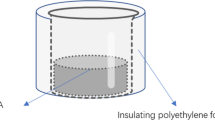Abstract
In this article, we study the use of thermally reduced graphene (TRG) for oil spill cleanup. TRG was synthesized by thermal exfoliation of graphite oxide and characterized by X-ray diffusion, Raman spectroscopy, SEM, TEM, elemental analysis, and Brunauer–Emmett–Teller (BET) surface area measurement. Various aspects of the sorption process have been studied including the sorption capacity, the recovery of the adsorbed oil, and the recyclability of TRG. Our results shows that TRG has a higher sorption capacity than any other carbon-based sorbents, with sorption capacity as high as 131 g of oil per gram TRG. With recovery of the sorbed oil via filtration and reuse of TRG for up to six cycles, 1 g of TRG collectively removes approximately 300 g of crude oil. Moreover, the effects of TRG bulk density, pore volume, and carbon/oxygen ratio and the oil viscosity on the sorption process are also discussed.












Similar content being viewed by others
References
Adebajao MO, Frost RL, Kloprogge JT, Carmody O, Kokot S (2003) Porous materials for oil spills cleanup: a review of synthesis, characterisation and evaluation of absorbing properties. J Porous Mater 10:159–170
Aksay IA, Milius DL, Korkut S, Prud'Homme RK (2011) Functionalized graphene sheets having high carbon to oxygen ratios. US Patent 2011/0,114,897
Annunciado TR, Sydenstricker THD, Amico SC (2005) Experimental investigation of various vegetable fibers as sorbent materials for oil spills. Mar Pollut Bull 50:1340–1346
Bastani D, Safekordi AA, Alihosseini A, Taghikhani V (2006) Study of oil sorption by expanded perlite at 298.15 K. Sep Purif Technol 52:295–300
Beck N, Meech S, Norman P, Pears L (2002) Characterisation of surface oxides on carbon and their influence on dynamic adsorption. Carbon 40:531–540
Choi HM, Cloud RM (1992) Natural sorbents in oil spill cleanup. Environ Sci Technol 26:772–776
Fan Z, Yan J, Ning G, Wei T, Qian W, Zhang S, Zheng C, Zhang Q, Wei F (2010) Oil sorption and recovery by using vertically aligned carbon nanotubes. Carbon 48:4197–4200
Gammoun A, Tahiri S, Albizane A, Azzi M, Moros J, Garrigues S, de la Guardia M (2007) Separation of motor oils, oily wastes and hydrocarbons from contaminated water by sorption on chrome shavings. J Hazard Mater 145:148–153
Gupta A, Chen G, Joshi P, Tadigadapa S, Eklund P (2006) Raman scattering from high-frequency phonons in supported n-graphene layer films. Nano Lett 6:2667–2673
Inagaki M, Konno H, Toyoda M, Moriya K, Kihara T (2000) Sorption and recovery of heavy oils by using exfoliated graphite. Part II: recovery of heavy oil and recycling of exfoliated graphite. Desalination 128:213–218
Inagaki M, Kawahara A, Konno H (2002) Sorption and recovery of heavy oils using carbonized fir fibers and recycling. Carbon 40:105–111
Kaji R, Muranaka Y, Otsuka K, Hishinuma Y (1986) Water absorption by coals: effects of pore structure and surface oxygen. Fuel 65:288–291
Kim H, Abdala AA, Macosko CW (2010) Graphene/polymer nanocomposites. Macromolecules 43:6515–6530
Liang HW, Guan QF, Chen LF, Zhu Z, Zhang WJ, Yu SH (2012) Macroscopic-scale template synthesis of robust carbonaceous nanofiber hydrogels and aerogels and their applications. Angew Chem Int ed 51:5101–5105
Lim TT, Huang X (2007) Evaluation of kapok (Ceiba pentandra (L.) Gaertn.) as a natural hollow hydrophobic–oleophilic fibrous sorbent for oil spill cleanup. Chemosphere 66:955–963
Margesin R, Schinner F (2001) Biodegradation and bioremediation of hydrocarbons in extreme environments. Appl Microbiol Biotechnol 56:650–663
McAllister MJ, Li JL, Adamson DH, Schniepp HC, Abdala AA, Liu J, Herrera-Alonso M, Milius DL, Car R, Prud'homme RK, Aksay IA (2007) Single sheet functionalized graphene by oxidation and thermal expansion of graphite. Chem Mater 19:4396–4404
Meyer JC, Geim A, Katsnelson M, Novoselov K, Booth T, Roth S (2007) The structure of suspended graphene sheets. Nature 446:60–63
Ni Z, Wang Y, Yu T, Shen Z (2008) Raman spectroscopy and imaging of graphene. Nano Res 1:273–291
Nishi Y, Dai G, Iwashita N, Sawada Y, Inagaki M (2002a) Evaluation of sorption behavior of heavy oil into exfoliated graphite by wicking test. Mater Sci Res Int 8:243–248
Nishi Y, Iwashita N, Sawada Y, Inagaki M (2002b) Sorption kinetics of heavy oil into porous carbons. Water Res 36:5029–5036
Novoselov KS, Geim AK, Morozov SV, Jiang D, Zhang Y, Dubonos SV, Grigorieva IV, Firsov AA (2004) Electric field effect in atomically thin carbon films. Science 306:666–669
Oebius HU (1999) Physical properties and processes that influence the clean up of oil spills in the marine environment. Spill Sci Technol Bull 5:177–289
Prud'homme RK, Aksay IA, Adamson D, Abdala A (2010) Thermally exfoliated graphite oxide. US Patent 7,658,901
Roberts CM, McClean CJ, Veron JEN, Hawkins JP, Allen GR, McAllister DE, Mittermeier CG, Schueler FW, Spalding M, Wells F, Vynne C, Werner TB (2002) Marine biodiversity hotspots and conservation priorities for tropical reefs. Science 295:1280–1284
Staudenmaier L (1898) Method for the preparation of graphitic acid. Ber Dtsch Chem Ges 31:1481–1487
Swannell RP, Lee K, McDonagh M (1996) Field evaluations of marine oil spill bioremediation. Microbiol Rev 60:342–365
Toyoda M, Inagaki M (2000) Heavy oil sorption using exfoliated graphite: new application of exfoliated graphite to protect heavy oil pollution. Carbon 38:199–210
Toyoda M, Aizawa J, Inagaki M (1998) Sorption and recovery of heavy oil by using exfoliated graphite. Desalination 115:199–201
Toyoda M, Moriya K, J-i A, Konno H, Inagaki M (2000) Sorption and recovery of heavy oils by using exfoliated graphite. Part I: maximum sorption capacity. Desalination 128:205–211
Wang Y, Ni Z, Shen Z, Wang H, Wu Y (2008) Interference enhancement of Raman signal of graphene. Appl Phys Lett 92:043121
Yang SZ, Jin HJ, Wei Z, He RX, Ji YJ, Li XM, Yu SP (2009) Bioremediation of oil spills in cold environments: a review. Pedosphere 19:371–381
Acknowledgment
The authors would like to thank Dr. Saeed Alhassan and the Catalysis Group at the Department of Chemical Engineering, the Petroleum Institute, Abu Dhabi, for assistance with the characterization of TRG.
Author information
Authors and Affiliations
Corresponding author
Additional information
Responsible editor: Philippe Garrigues
Rights and permissions
About this article
Cite this article
Iqbal, M.Z., Abdala, A.A. Oil spill cleanup using graphene. Environ Sci Pollut Res 20, 3271–3279 (2013). https://doi.org/10.1007/s11356-012-1257-6
Received:
Accepted:
Published:
Issue Date:
DOI: https://doi.org/10.1007/s11356-012-1257-6




